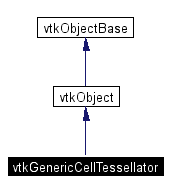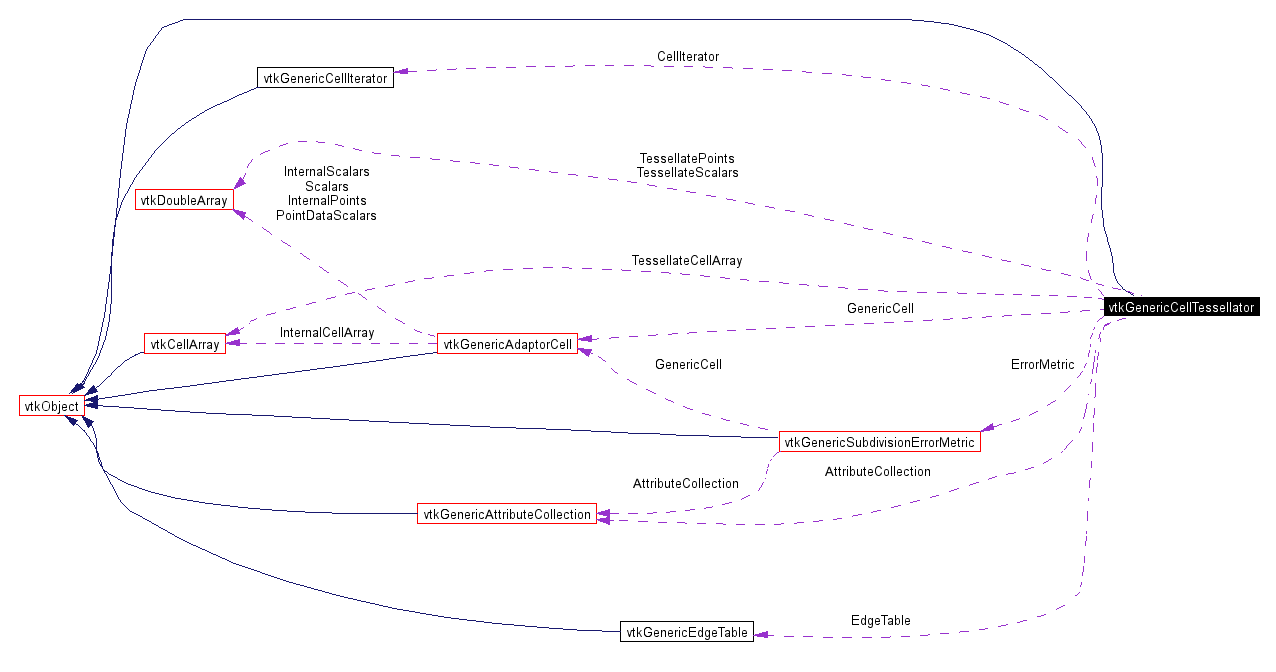vtkGenericCellTessellator Class Reference
#include <vtkGenericCellTessellator.h>
Inheritance diagram for vtkGenericCellTessellator:
 [legend]
[legend]Collaboration diagram for vtkGenericCellTessellator:
 [legend]List of all members.
[legend]List of all members.
Detailed Description
helper class to perform cell tessellation
vtkGenericCellTessellator is a helper class to perform adaptive tessellation of particular cell topologies. The major purpose for this class is to transform higher-order cell types (e.g., higher-order finite elements) into linear cells that can then be easily visualized by VTK. This class works in conjunction with the vtkGenericDataSet and vtkGenericAdaptorCell classes.
This algorithm is based on edge subdivision. An error metric along each edge is evaluated, and if the error is greater than some tolerance, the edge is subdivided (as well as all connected 2D and 3D cells). The process repeats until the error metric is satisfied.
A significant issue addressed by this algorithm is to insure face compatibility across neigboring cells. That is, diagaonals due to face triangulation must match to insure that the mesh is compatible. The algorithm employs a precomputed table to accelerate the ttessellation process. The table was generated with the help of vtkOrderedTriangulator; the basic idea is that the choice of diagonal is made by considering the relative value of the point ids.
- Created by:
-
- CVS contributions (if > 5%):
-
- CVS logs (CVSweb):
/Filtering/vtkGenericCellTessellator.cxx)/Filtering/vtkGenericCellTessellator.h)
- Tests:
- vtkGenericCellTessellator (Tests)
Definition at line 70 of file vtkGenericCellTessellator.h.
|
[NOHEADER] |
| void | InsertEdgesIntoEdgeTable (vtkTriangleTile &tri) |
| void | RemoveEdgesFromEdgeTable (vtkTriangleTile &tri) |
| void | InsertPointsIntoEdgeTable (vtkTriangleTile &tri) |
| vtkGenericEdgeTable * | EdgeTable |
Public Types |
| typedef vtkObject | Superclass |
Public Member Functions |
| virtual const char * | GetClassName () |
| virtual int | IsA (const char *type) |
| void | PrintSelf (ostream &os, vtkIndent indent) |
| void | Reset () |
| void | Initialize (vtkIdType numPts) |
| vtkGenericEdgeTable * | GetEdgeTable () |
|
| virtual vtkGenericAdaptorCell * | GetGenericCell () |
|
| virtual void | TessellateTriangleFace (vtkGenericAdaptorCell *cell, vtkGenericAttributeCollection *att, vtkIdType index, vtkDoubleArray *points, vtkCellArray *cellArray, vtkDoubleArray *scalars) |
|
| void | Tessellate (vtkGenericAdaptorCell *cell, vtkGenericAttributeCollection *att, vtkDoubleArray *points, vtkCellArray *cellArray, vtkDoubleArray *scalars) |
|
| void | Triangulate (vtkGenericAdaptorCell *cell, vtkGenericAttributeCollection *att, vtkDoubleArray *points, vtkCellArray *cellArray, vtkDoubleArray *scalars) |
|
| virtual void | SetErrorMetric (vtkGenericSubdivisionErrorMetric *subAlgorithm) |
| virtual vtkGenericSubdivisionErrorMetric * | GetErrorMetric () |
Static Public Member Functions |
| vtkGenericCellTessellator * | New () |
| int | IsTypeOf (const char *type) |
| vtkGenericCellTessellator * | SafeDownCast (vtkObject *o) |
Protected Member Functions |
| | vtkGenericCellTessellator () |
| | ~vtkGenericCellTessellator () |
| void | InsertEdgesIntoEdgeTable (vtkTetraTile &tetra) |
| void | RemoveEdgesFromEdgeTable (vtkTetraTile &tetra) |
| void | InsertPointsIntoEdgeTable (vtkTetraTile &tetra) |
| void | InternalTessellateTriangle (vtkTriangleTile &root) |
| int | FindEdgeReferenceCount (double p1[3], double p2[3], vtkIdType &e1, vtkIdType &e2) |
| int | GetNumberOfCellsUsingFace (int faceId) |
| int | GetNumberOfCellsUsingEdge (int edgeId) |
| int | IsEdgeOnFace (double p1[3], double p2[3]) |
| int | FindEdgeParent2D (double p1[3], double p2[3], int &localId) |
| int | FindEdgeParent (double p1[3], double p2[3], int &localId) |
Protected Attributes |
| vtkGenericAdaptorCell * | GenericCell |
| vtkGenericCellIterator * | CellIterator |
| vtkGenericAttributeCollection * | AttributeCollection |
| vtkGenericSubdivisionErrorMetric * | ErrorMetric |
|
| double * | Scalars |
| int | ScalarsCapacity |
|
| vtkDoubleArray * | TessellatePoints |
| vtkCellArray * | TessellateCellArray |
| vtkDoubleArray * | TessellateScalars |
Member Typedef Documentation
Constructor & Destructor Documentation
| vtkGenericCellTessellator::vtkGenericCellTessellator |
( |
|
) |
[protected] |
|
Member Function Documentation
|
|
Create an object with Debug turned off, modified time initialized to zero, and reference counting on.
Reimplemented from vtkObject. |
| virtual const char* vtkGenericCellTessellator::GetClassName |
( |
|
) |
[virtual] |
|
| int vtkGenericCellTessellator::IsTypeOf |
( |
const char * |
type |
) |
[static] |
|
|
|
Return 1 if this class type is the same type of (or a subclass of) the named class. Returns 0 otherwise. This method works in combination with vtkTypeRevisionMacro found in vtkSetGet.h.
Reimplemented from vtkObject. |
| virtual int vtkGenericCellTessellator::IsA |
( |
const char * |
type |
) |
[virtual] |
|
|
|
Return 1 if this class is the same type of (or a subclass of) the named class. Returns 0 otherwise. This method works in combination with vtkTypeRevisionMacro found in vtkSetGet.h.
Reimplemented from vtkObject. |
| void vtkGenericCellTessellator::PrintSelf |
( |
ostream & |
os, |
|
|
vtkIndent |
indent |
|
) |
[virtual] |
|
|
|
Methods invoked by print to print information about the object including superclasses. Typically not called by the user (use Print() instead) but used in the hierarchical print process to combine the output of several classes.
Reimplemented from vtkObject. |
|
|
Get the higher order cell in order to access the evaluation function. |
|
|
Tessellate a face of a tetrahedron cell. The face is specified by the index value. - Precondition:
- cell_exists: cell!=0
is_a_tetra: (cell->GetType()==VTK_TETRA) ||(cell->GetType()==VTK_QUADRATIC_TETRA) ||(cell->GetType()==VTK_HIGHER_ORDER_TETRAHEDRON)
valid_index_range: (index>=0) && (index<4)
|
|
|
Tessellate a tetrahedron `cell'. The result is a set of smaller linear cells `cellArray' with `points' and point data `scalars'. - Precondition:
- cell_exists: cell!=0
is_a_tetra: (cell->GetType()==VTK_TETRA) ||(cell->GetType()==VTK_QUADRATIC_TETRA) ||(cell->GetType()==VTK_HIGHER_ORDER_TETRAHEDRON)
|
|
|
Triangulate a triangle `cell'. - Precondition:
- cell_exists: cell!=0
is_a_triangle: (cell->GetType()==VTK_TRIANGLE) ||(cell->GetType()==VTK_QUADRATIC_TRIANGLE) ||(cell->GetType()==VTK_HIGHER_ORDER_TRIANGLE)
|
|
|
Specify the object to use to compute the error metric. |
|
|
Specify the object to use to compute the error metric. |
| void vtkGenericCellTessellator::Reset |
( |
|
) |
|
|
|
|
Reset the output for repeated use of this class. |
| void vtkGenericCellTessellator::Initialize |
( |
vtkIdType |
numPts |
) |
|
|
|
|
Initialize the internal hash table. |
|
|
Return the internal edge table. |
| void vtkGenericCellTessellator::InsertEdgesIntoEdgeTable |
( |
vtkTriangleTile & |
tri |
) |
[protected] |
|
| void vtkGenericCellTessellator::RemoveEdgesFromEdgeTable |
( |
vtkTriangleTile & |
tri |
) |
[protected] |
|
| void vtkGenericCellTessellator::InsertPointsIntoEdgeTable |
( |
vtkTriangleTile & |
tri |
) |
[protected] |
|
| void vtkGenericCellTessellator::InsertEdgesIntoEdgeTable |
( |
vtkTetraTile & |
tetra |
) |
[protected] |
|
| void vtkGenericCellTessellator::RemoveEdgesFromEdgeTable |
( |
vtkTetraTile & |
tetra |
) |
[protected] |
|
| void vtkGenericCellTessellator::InsertPointsIntoEdgeTable |
( |
vtkTetraTile & |
tetra |
) |
[protected] |
|
| void vtkGenericCellTessellator::InternalTessellateTriangle |
( |
vtkTriangleTile & |
root |
) |
[protected] |
|
|
|
Internal function used to tessellate a triangle |
| int vtkGenericCellTessellator::FindEdgeReferenceCount |
( |
double |
p1[3], |
|
|
double |
p2[3], |
|
|
vtkIdType & |
e1, |
|
|
vtkIdType & |
e2 |
|
) |
[protected] |
|
| int vtkGenericCellTessellator::GetNumberOfCellsUsingFace |
( |
int |
faceId |
) |
[protected] |
|
| int vtkGenericCellTessellator::GetNumberOfCellsUsingEdge |
( |
int |
edgeId |
) |
[protected] |
|
| int vtkGenericCellTessellator::IsEdgeOnFace |
( |
double |
p1[3], |
|
|
double |
p2[3] |
|
) |
[protected] |
|
|
|
Is the edge defined by vertices (`p1',`p2') in parametric coordinates on some edge of the original tetrahedron? If yes return on which edge it is, else return -1. - Precondition:
- p1!=p2
p1 and p2 are in bounding box (0,0,0) (1,1,1)
- Postcondition:
- valid_result: (result==-1) || ( result>=0 && result<=5 )
|
| int vtkGenericCellTessellator::FindEdgeParent2D |
( |
double |
p1[3], |
|
|
double |
p2[3], |
|
|
int & |
localId |
|
) |
[protected] |
|
|
|
Return 1 if the parent of edge defined by vertices (`p1',`p2') in parametric coordinates, is an edge; 3 if there is no parent (the edge is inside). If the parent is an edge, return its id in `localId'. - Precondition:
- p1!=p2
p1 and p2 are in bounding box (0,0,0) (1,1,1)
- Postcondition:
- valid_result: (result==1)||(result==3)
|
| int vtkGenericCellTessellator::FindEdgeParent |
( |
double |
p1[3], |
|
|
double |
p2[3], |
|
|
int & |
localId |
|
) |
[protected] |
|
|
|
Return 1 if the parent of edge defined by vertices (`p1',`p2') in parametric coordinates, is an edge; 2 if the parent is a face, 3 if there is no parent (the edge is inside). If the parent is an edge or a face, return its id in `localId'. - Precondition:
- p1!=p2
p1 and p2 are in bounding box (0,0,0) (1,1,1)
- Postcondition:
- valid_result: result>=1 && result<=3
|
Member Data Documentation
|
|
Scalar buffer used to save the interpolate values of the attributes The capacity is at least the number of components of the attribute collection ot the current cell.
Definition at line 159 of file vtkGenericCellTessellator.h. |
|
|
Scalar buffer used to save the interpolate values of the attributes The capacity is at least the number of components of the attribute collection ot the current cell.
Definition at line 160 of file vtkGenericCellTessellator.h. |
The documentation for this class was generated from the following file:

